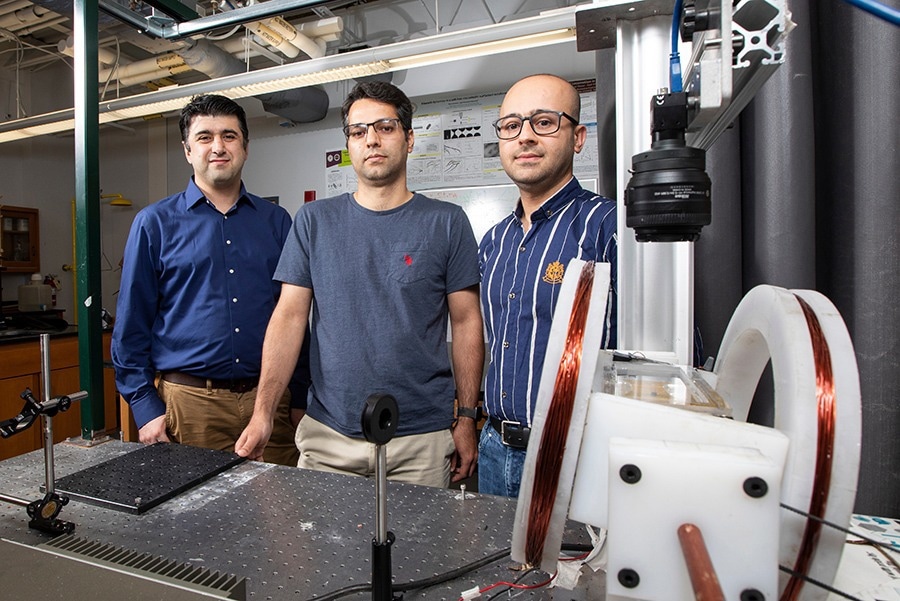Helicobacter pylori is a common and deadly spiral-shaped bacteria. More than 13% of Americans have H. pylori infection, though rates vary depending on age, race, and socioeconomic level. The microbe propels itself forward through viscous fluids like stomach mucus using its corkscrew-like tail. When it reaches the stomach wall's epithelium, it can cause everything from ulcers to cancer.
 Kourosh Shoele, an Assistant Professor of Mechanical Engineering, Hadi Mohammadigoushki, Associate Professor of Chemical and Biomedical Engineering and Farshad Nazarinasrabad, a Doctoral Candidate in chemical engineering at the FAMU-FSU College of Engineering. Image Credit: Mark Wallheiser/FAMU-FSU College of Engineering.
Kourosh Shoele, an Assistant Professor of Mechanical Engineering, Hadi Mohammadigoushki, Associate Professor of Chemical and Biomedical Engineering and Farshad Nazarinasrabad, a Doctoral Candidate in chemical engineering at the FAMU-FSU College of Engineering. Image Credit: Mark Wallheiser/FAMU-FSU College of Engineering.
FAMU-FSU College of Engineering scientists have created a 3D model of this bacteria to better comprehend its movement, with the goal of solving the puzzle governing the organism’s motility and developing alternative treatments for infections, like strengthening the gastric mucus barrier that protects against the bacteria.
People around the world have treated ulcers with antibiotics because antibiotics kill bacteria, but it’s a double-edged sword. If we understand how these bacteria move, we can work toward providing other solutions for treatment.”
Hadi Mohammadigoushki, Study Co-Author and Associate Professor, Department of Chemical and Biomedical Engineering, Florida State University
In the experiments, the researchers immersed a bacteria model in a high-viscosity polymer gel, which is an example of a yield-stress fluid. Under minor stresses, these fluids behave as solids but flow as liquids beyond a vital stress point.
The 3D model was then rotated using a magnetic field to simulate the activity of the bacteria. The researchers assessed the speed of the bacteria and saw the distribution and density of the fluid flowing around it using particle tracking and imaging techniques.
The scientists found two essential thresholds that the bacteria must cross: the torque required to rotate the swimming model and the force required to propel the model forward.
We found that if the tail propulsion was too weak, the bacteria remain stuck in the gel. If the force was strong enough it could penetrate the gel. It’s kind of like when you are drilling a screw into a solid wall. If your drill isn’t strong enough and you are not pushing the screw with enough force, it won’t penetrate the wall, but with the right amount of force, it can break through.”
Hadi Mohammadigoushki, Study Co-Author and Associate Professor, Department of Chemical and Biomedical Engineering, Florida State University
The swimming motions and power that allow H. pylori to move also apply to larger objects like earthworms that burrow in the soil, parasites, and other organisms.
“If we understand how the bacteria successfully move to attack our body, we can use that information for whatever we can imagine,” states Kourosh Shoele, an Assistant Professor in the Department of Mechanical Engineering.
Shoele is a member of the multidisciplinary research team and a computational science expert. He described how learning from nature might improve mechanical and biological systems’ responses.
Shoele concludes, “In the future, we can design a micro-robot that can deliver a drug to a particular location in the body, in terms of fighting leukemia and other diseases. Or perhaps we can design tiny robots that use swimming motion and force, like H. pylori, that can dig deep in the sand to explore for water or oil. The possibilities are endless.”
Source:
Journal reference:
Nazari, F., et al. (2023). Helical Locomotion in Yield Stress Fluids. Physical Review Letters. doi.org/10.1103/physrevlett.130.114002.